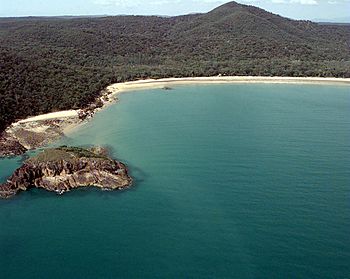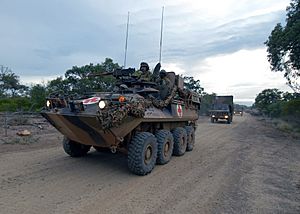Shoalwater Bay facts for kids
Quick facts for kids Shoalwater |
|
|---|---|

Freshwater Bay in the Shoalwater Bay Military Training Area
|
|

Shoalwater Bay in the north of the Capricorn coast region
|
|
| Country | Australia |
| State | Queensland |
| Region | Central Queensland |
| Basin features | |
| Protection status | |
| Official name: Shoalwater and Corio Bays | |
| Designated: | 1 March 1996 |
| Reference #: | 792 |
Shoalwater Bay is a large bay located on the Capricorn Coast in Central Queensland, Australia. It is about 100 kilometers (62 miles) north of the town of Yeppoon. The state capital, Brisbane, is 628 kilometers (390 miles) to the south-southeast.
Since 1966, the land around Shoalwater Bay has been used by the Australian Defence Force for military training. The bay is also an important home for dugongs, which are often called "sea cows." It is part of the larger Great Barrier Reef Marine Park. The bay is surrounded by the Torilla Peninsula to the west and the Warginburra Peninsula, along with Leicester Island and Townshend Island, to the east.
Contents
History of Shoalwater Bay
First People of Shoalwater Bay
The original people who lived in the Shoalwater Bay area are known as the Darumbal people. Their language, also called Darumbal, was spoken in a wide area. This area stretched from the city of Rockhampton south to Raglan Creek and north towards the Styx River. It also went inland along the Broad Sound Ranges.
Different groups of Darumbal people lived in specific parts of the area. For example, the Cookeeburra people lived on the Warginburra Peninsula. The Risteburra people were from Raspberry Creek, and the Cooinmurburra people lived on the plains of Torilla. The Woppaburra people were the traditional owners of the islands in the region.
European Exploration and Settlement
The first European to see Shoalwater Bay was the British explorer James Cook on May 28, 1770. Cook called the whole area, including Shoalwater Bay, the "Bay of Inlets." This name is not used anymore. Cook named this specific bay "Shoalwater Bay" because of the many sandbars found there.
Later, in 1802, Matthew Flinders explored Shoalwater Bay more closely. He landed on Akens Island, a small island on the western side of the bay. Flinders described the land as having stony hills, some covered with grass and trees. He also noted that fresh water could be found in ponds at the base of the hills.
European settlement in the Shoalwater Bay region began in 1858. By the early 1860s, the land was divided into four large farms, called pastoral stations. These were Tilpal, Raspberry Creek, The Peninsula, and Torilla. The arrival of European settlers led to conflicts with the local Aboriginal people.
Tilpal Station
Tilpal was started as a sheep station in the late 1850s by "Hobby" Elliott. Soon after, there was a conflict between Elliott's workers and the local Aboriginal people. The Native Police were called in, and more conflicts occurred. Elliott later sold Tilpal, and a small gold rush happened there in the late 1860s.
Raspberry Creek Station
Raspberry Creek was first settled by James Ross and James Hutton. Hutton began building a home there in 1861. The Risteburra people, who lived there, sometimes hunted Hutton's cattle. The Native Police were called to the area, which led to further conflicts. The Hutton family owned Raspberry Creek until 1917.
The Peninsula Station
Edward Hampton Baker, also known as "Cranky" Baker, started The Peninsula Station. This station covered the entire area now known as the Warginburra Peninsula. Baker often had conflicts with the local Cookeeburra people. In 1876, Baker sold The Peninsula to James Hutton, who owned the nearby Raspberry Creek property.
Torilla Station
Torilla Station was established by Frank Newbold in 1858. Newbold did not want the local Cooinmurburra people on his property, which caused conflict. In 1868, a group of Cooinmurburra people attacked the Newbold family's home. Around twenty Aboriginal people died in the conflict that followed. The Newbold and Rogers families owned Torilla for many years. The town of Stanage, located on the Torilla property, was founded by the Rogers family in the early 1870s.
Shoalwater Bay Military Training Area
The Shoalwater Bay Military Training Area is very large, covering 4,545 square kilometers (1,755 square miles). It includes the Warginburra Peninsula, part of the Torilla Peninsula, Townshend and Leicester Islands, and a large area of land north of the village of Byfield.
The idea of using Shoalwater Bay for military training first came up in 1960. The Australian army officially took control of the land on July 1, 1965. By the next year, all the original landowners had moved out. This training area was used by soldiers who were sent to the Vietnam War.
In 2005, the Australian government made a long-term agreement with the United States. This agreement allows the US military to use Shoalwater Bay for training exercises. Similar, but shorter, agreements have also been made with the Singapore Ministry of Defence.
Military exercises with the United States have caused some debate in the Rockhampton-Yeppoon area. People have raised concerns about possible environmental damage to the Shoalwater Bay region. There have also been concerns, though not proven, about certain types of weaponry being used during training. Peace activists who were protesting a military exercise called Exercise Talisman Saber were arrested in 2009.
Some local leaders, like former Rockhampton mayor Brad Carter and current mayor Margaret Strelow, have supported the idea of a permanent US military presence in the area.
On August 7, 2017, the Australian Navy found a missing US military aircraft that had crashed off Australia's east coast. Three US Marines were missing after this accident involving an MV-22 aircraft. Twenty-three of the 26 people on board the aircraft were rescued.
Environment and Wildlife
Shoalwater Bay is home to one of the most important seagrass areas in the entire Great Barrier Reef Marine Park. Seagrass is like underwater grass and provides food and shelter for many marine animals.
A special plan was created in 1997 to help protect the bay's dugong population. This plan aims to keep the dugongs safe and reduce any harm to their seagrass feeding grounds.
Important Bird Area
A large part of the bay and its surrounding areas, about 483 square kilometers (186 square miles), has been named an Important Bird Area (IBA) by BirdLife International. This is because it provides a perfect home for many migratory waders, also known as shorebirds.
This area supports more than 1% of the world's populations of certain birds, such as pied oystercatchers, Far Eastern curlews, and grey-tailed tattlers. It also supports over 1% of the East Asian – Australasian Flyway populations of bar-tailed godwits, Eurasian whimbrels, and Terek sandpipers. You can also find beach stone-curlews and mangrove honeyeaters living here.
Shoalwater Bay in Popular Culture
- Shoalwater Bay is mentioned in the song "I Was Only Nineteen" by the band Redgum. This song was a number one hit in 1983.
- It is also mentioned in the video game ARMA 2. In the game, a US Marine Corps private talks about having a good time with the "Aussies at Shoalwater Bay."


